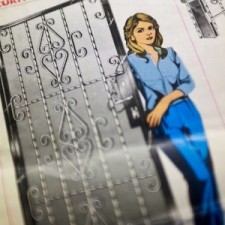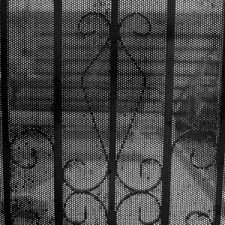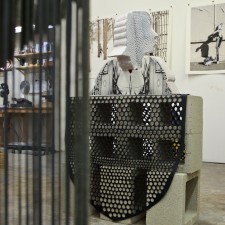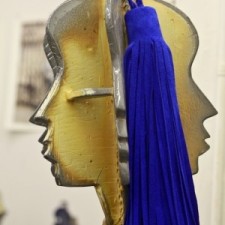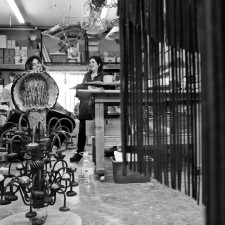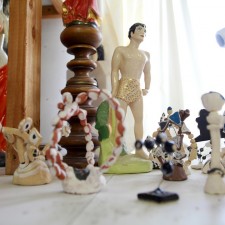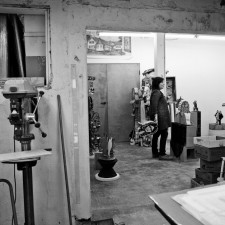Link to full article on In the Make.
A lot happens in Bari’s Glasell Park studio. This became clear as soon as we set foot into her space— various objects and materials were scattered about and multiple projects seemed to be underway. Bari has a multifaceted practice that includes ceramic sculptural work, a design line, and various collaborations and she moves between each with a fair amount of ease and focus. I’m always a little surprised when artists manage to do this without becoming discombobulated or overwhelmed; there is always the risk of an effort becoming diluted or disjointed if there are too many influences and ideas on hand.
Yet a good deal of coherence was present in Bari’s work, particularly her series DECORATIVE PROTECTION which she was just finishing up when we visited and is now on exhibit at Emma Gray HQ in Los Angeles. This body of work examines how objects like fences and window bars relate to the female figure, specifically concerning notions of safety and seduction. Inspired by a ‘80s advertisement for wrought iron window bars, Bari draws a parallel between domestic security and womanhood, and explores how in both cases the expectation is that external appearances should be alluring yet simultaneously impenetrable. It’s an unexpected comparison, but by investigating outer displays and protection in the domestic realm Bari considers how female psyche and instincts are formed. Among the sculptural pieces from this series I was particularly drawn to those that took on a human-like size and shape, standing erect and stoic with soft strands of leather falling from their form. Staggering to look at, with a towering, intimidating presence, like fictional she-warriors, these works unapologetically convey both threat and beauty.
As Bari continues to work at many things, I will be curious to see how she balances the different directions that her interests take her. There is a fluidity to her work, she seems to dip in and out of projects seamlessly and is able to grapple with many questions at once… and yet having stood in front of those totemic, almost mythological sculptures I couldn’t help but think that sometimes just one question is enough.
How would you describe your subject matter or the content of your work?
My question back would be which practice? That answer depends on which body of work I’m focused on— whether it is my fine art, public art, BZIPPY & CO. design line, or collaborative practice. For clarity’s sake, they all focus on a deep investment in experimentation and whimsy that make connections between the female figure, decoration and the urban environment, often using clay. There is a freedom in having multiple practices in which I can discern specific topics instead of squashing all of my ideas into one body of work. Often times the different practices loop back into each other; that’s when the lines start to dissolve and things become really interesting for me.
Currently I’m focused on the series DECORATIVE PROTECTION (2010 – present), which collapses the female figure by creating connections between the urban environment and decoration, while simultaneously wishing to protect and exalt the role of decoration, in both the arts and society at large. I examine how simple objects such as fences and iron window bars relate to the role of the female form in society, how such objects are designed to seduce and repel, arm and disarm. These totemic human scale ceramic sculptures and photographs are inspired by a ’80s magazine ad for wrought iron window bars. The advertisement, which affirms “not prison looking bars,” navigates the uneasy relationship between domestic security while maintaining a facade of looking pretty. Through form, decoration and outer displays and appearances, I’m examining how the shadow side of the female psyche is asserted. These fragmented surrealist sculptures allow new mythic figures to emerge that have adapted and mark a new territory in our urban environment.
What mediums do you work with?
My mediums are really tied to the concept or body of work I’m undertaking, most often I’m juggling multiple projects simultaneously which lends itself to fluent shifts between clay, photography, paper mache, wood or collage. I’ve just finished up DECORATIVE PROTECTION sculptural works for a solo exhibition with Emma Gray HQ in Los Angeles made of clay and leather. For the past five years, my main medium has been clay while the leather is a new addition inspired by a proposed installation commission by FENDI that was shelved. The combination of leather and ceramic owes as much to mythic Roman warriors as it does a Greek Goddess, not to mention modern day female pop icons, whose outfits also actively seduce and repel. Clay is initially so transformative but ultimately fixed and the leather adds a sexy, supple component to the work, and it brings in a lot of movement.
Part of your practice is to re-assemble once functional domestic objects— how do you go about finding these objects, what’s your criteria for this process?
Currently, this part of my practice is focused on public artwork with the projects 1,095: One Year’s Worth of Other People’s Plates (LACMA & Bristol Biennial) and RECOLLECTED: longing for a home.
At LACMA and the Bristol Biennial, I invited the public to contribute their dinner plates to 1,095: One Years Worth of Other People’s Plates—a temporary, interactive three-dimensional installation of one year’s worth of other people’s plates in the shape of a mandala. The project is part swap meet, part sculpture. The plates were collected via social networking from individual donors and from local thrift shops. Donors would come by my studio for a drop off or I’d drive all over LA to stranger’s homes— I was constantly on an adventure! The collected plates were affixed with a commemorative sticker and edition number, and then were redistributed back to donors in the amount of their original donation. This sculpture-in-flux provided a point of convergence where ordinary objects were temporarily transformed before returning to their everyday status. Though a fleeting sculpture, the project lives on in the homes of those who participated. I’ve heard stories of people washing dishes at friends’ houses post dinner party when they discover the commemorative sticker on the back!
RECOLLECTED: longing for a home, was a site-specific public art installation in Long Beach that was funded by the Arts Council of Long Beach. With this project, I was primarily concerned with the absurd culture of collecting domestic objects and the desire associated with redecorating. I installed hundreds of colorful vases from Long Beach thrift stores and created a window installation in a former commercial space. At the conclusion of the exhibition, all of the vases were returned and the project lives on in the homes of the community as each vase is resold featuring a commemorative hangtag, marking the vases’ participation in this temporary installation. Similar to the plate project, I often receive pictures and emails from Long Beach thrift store shoppers who picked up a vase and have it displayed in their homes. That’s a treat to begin to trace the object as it lives on post-installation.
How has LA as a landscape, both culturally and aesthetically, influenced your work?
Los Angeles can be an isolating city with its car culture, traffic, lack of a walking life, and the entertainment industry. But I’m not very interested in hiding behind those LA stereotypes; I’d rather dive straight in. I particularly love Los Angeles on my 2 AM drive from my eastside Glassell Park studio heading west on Beverly Blvd to my apartment in Mid Wilshire West. These drives to and from the studio take me through drastic shifts in cultural neighborhoods and architecture. I’m constantly taking mental notes of the various metal gates and window bar patterns; how they are designed to protect and beautify homes. Those decompressing drives after a long day alone in the studio can be magical and eerie with its misty marine layer and empty streets. The possibility and pulse of the city shifts without the commuter buzz; there is a quietness, which I find very regenerative.
Culturally, I’m surrounded by innovative and rigorous artists and crafts makers who I’m continually inspired by. In Los Angeles, any thing is possible in terms of material sourcing and fabrication. Mitzi Guidry is one of the cofounders of the all female owned company Los Angeles Leather Craft and I’ve been collaborating with her on all things leather for the past year. Her full service leathercraft studio specializes in manufacturing private label leather accessories. As an artist this was an amazing opportunity to have her craftsmen develop custom leather decorative elements for my ceramic sculptures. With our two perspectives of fine art and leathercrafting, Mitzi has been able to bring my fantastical and often idiosyncratic visions of leather to reality. During our evening meetings we do as much talking as inventing!
Do you see your work as autobiographical at all?
The work usually starts from a place of autobiography with some projects more overtly personal than others— specifically, my public art focusing on reassembled found domestic objects. Culling thrift stores and seeking out strangers’ homes for the perfect object was how I spent many weekends in Chicago growing up. My father was an avid collector of ceramic cookie jars, bakelite radios, and vintage clothing. His hunger for the next object was normal— as palettes of his collection lay dormant while others were carefully curated into his home. While on these treasure hunting trips, I learned very early on how to understand the value of the object based on my father’s taste, color, shape, manufacturer, or edition. My projects that involve collecting domestic objects are a direct relationship to my own narrative. But there is whole consumer and TV culture around garage sales and collecting which makes these projects accessible beyond my own narrative.
The series DECORATIVE PROTECTION, started in a personal place of trying to physically and psychologically understand anxiety and how as a woman the urban environment is a bodily trigger. It’s so drilled into us as women to be sexy, but to simultaneously be on guard, to be tough. From its initial conceptual thread, the current sculptural works have opened up to find a more poetic formal relationship between urban symbols and seductive materials. I believe that my sculptures have the power to be transformative for the viewer in which they encounter a new mythic figure that has adapted and marks a new territory in our urban environment.
What does having a physical space to make art in mean for your process, and how do you make your space work for you?
I’ve been in this current studio since 2004, just after graduating from CalArts. My studio mate Jed Lind and I share a 2,000 sq. foot studio with private studios, a full shop and an urban back patio for dusty projects. Being a sculptor in LA is wonderful, most of the year I can work outside under the metal woven shade tarp.
This space has its challenges with an absent landlord, an ever-present hole in the ceiling, and deteriorating walls due to years of rain damage. Oh, and the giant water bugs, bees hives, black widows, and mice always keep me on my toes! Despite those challenges, this space has seen a lot of different configurations and bodies of work. As a sculptor, this space not only provides much needed storage but a space for privacy and magic. On this block, there are other artists such as Aaron Sandnes and James Melinat – where we are constantly exchanging tools, ideas, and feedback. Next door is a welder, the hardware store is a stone’s throw away, and the Verdugo Bar is around the block— it’s all here. If I ever moved out, it would be the end of an era. I’d miss my banter with Jed Lind the most, as he’s constantly telling me to clean my studio and huffing away in a humorous disgust.
Is there something you are currently working on, or are excited about starting that you can tell us about?
My upcoming public project, TOTEMS IN INDIGO, will be a temporary site-specific installation at Arcadia County Park commissioned by the Los Angeles County Arts Commission during the 2013 pool season opening on June 15. This project coincided with a Japanese indigo dying community workshop with Niki Livingston of Lookout & Wonderland where participants dyed canvas tote bags, which will become formal elements within my whimsical ceramic totem sculptures, and then will be given back to the community at the end of the project. These four totem sculptures of ceramic animal heads are glazed based on 14th Century Chinese pottery, which will mark the entrance of the newly renovated Arcadia Aquatic Center.
What three things never fail to bring you pleasure?
The transformative quality of clay, Marimekko patterns, and sleeping. I love to sleep.




